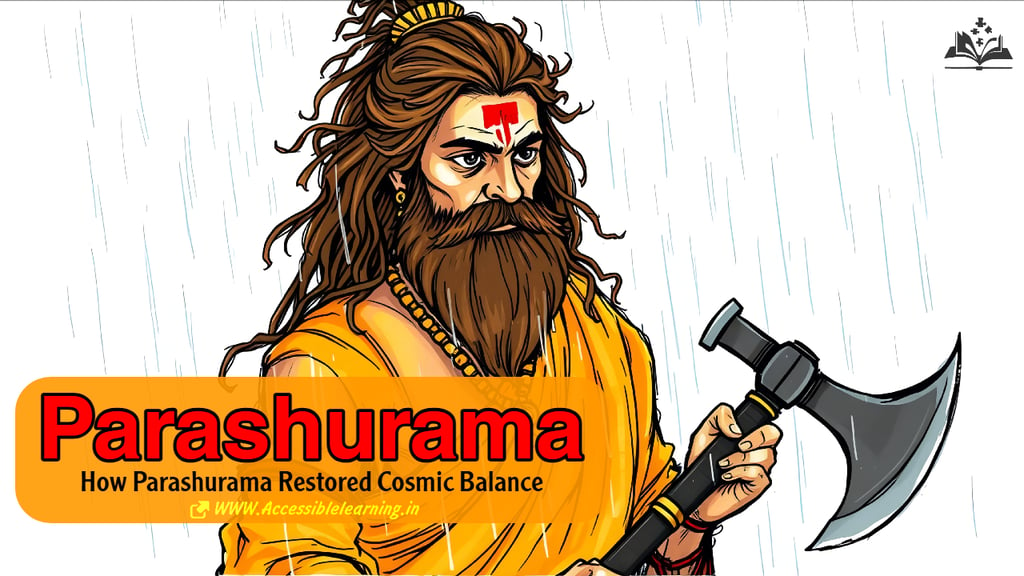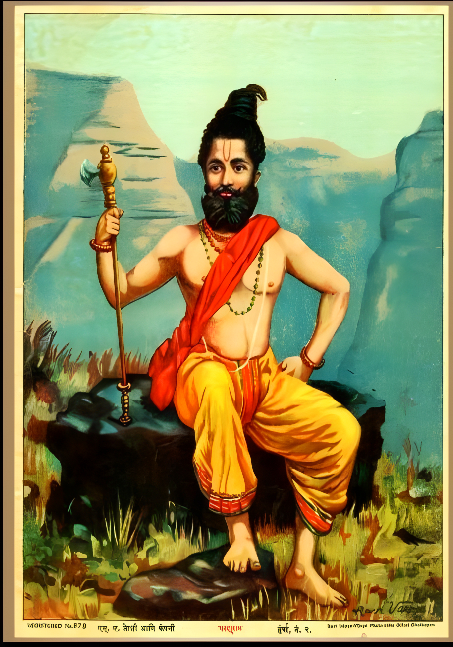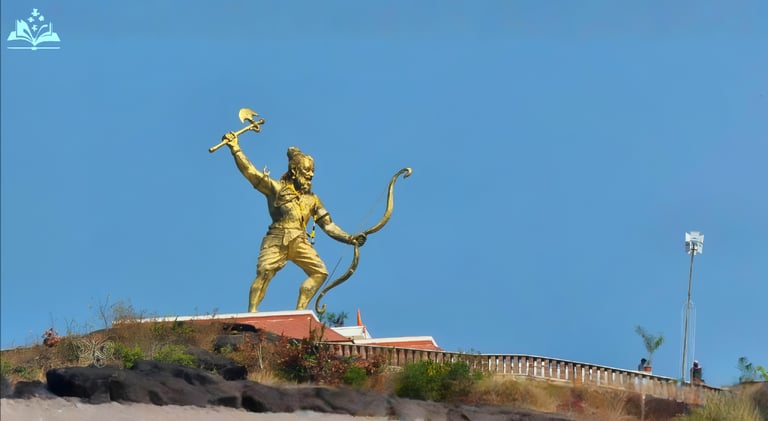
Parashurama: The Sixth Avatar of Vishnu Ji
Explore the fascinating story of Parashurama Ji, the sixth avatar of Vishnu, who transcended time and cosmic ages as both a fierce warrior and enlightened sage. This comprehensive guide delves into ancient scriptures to reveal his divine birth, legendary exploits, lasting legacy, and profound spiritual teachings that continue to inspire millions today.
EVENT/SPECIALCULTURE/TRADITIONINDIA/BHARATCELEBRATION/FESTIVALS
Sachin K Chaurasiya
4/21/202510 min read


Parashurama/परशुराम Ji stands as one of the most fascinating figures in Hindu mythology—a warrior sage who embodies both divine fury and spiritual wisdom. As the sixth avatar of Vishnu Ji, Parashurama occupies a unique position in Hindu tradition as the only avatar who lived during multiple cosmic ages, witnessing the events of different yugas. His story combines elements of righteousness, vengeance, sacrifice, and redemption, providing profound spiritual lessons that remain relevant today.
The Divine Origin
Born to the sage Jamadagni and his wife Renuka, Parashurama Ji's name derives from his primary weapon—the parashu (axe)—gifted to him by Shiv Ji after years of intense penance. Unlike other avatars of Vishnu, who typically manifested to restore cosmic balance during specific periods of crisis, Parashurama appeared during the Treta Yuga with a distinct purpose: to rid the earth of corrupt and tyrannical Kshatriya rulers who had abused their power.
His birth itself was marked by divine omens. When Renuka was pregnant with him, it is said that the earth trembled and the heavens shone with unusual light. His name, "Parashurama," combines "Parashu" (axe) and "Ram" (pleasing), signifying "Ram with an axe." He was also known as "Jamadagnya" (son of Jamadagni) and "Bhargava" (descendant of Bhrigu), connecting him to one of Hinduism's most revered sage lineages.
Early Life and Education
Before becoming the warrior of legend, Parashurama underwent rigorous training in both spiritual disciplines and martial arts. Under his father's guidance, he mastered the Vedas, Upanishads, and various branches of knowledge at an extraordinarily young age. His education was comprehensive, encompassing
Dhanurveda (science of archery and warfare)
Ayurveda (traditional medicine)
Astrology and astronomy
The arts of governance and diplomacy
His exceptional abilities attracted the attention of Shiv Ji himself, who became his guru in advanced martial arts. After years of dedicated service to Shiv Ji, Parashurama was gifted the divine axe (parashu) that would become his signature weapon. This axe was no ordinary weapon but symbolized the cutting away of ego and attachment—spiritual obstacles that bind one to the material world.
The Turning Point: A Son's Terrible Duty
The pivotal moment in Parashurama Ji's life came when King Kartavirya Arjuna, a thousand-armed Kshatriya ruler, visited his father's hermitage. After being hospitably received, the king stole the sacred cow Kamadhenu. When Parashurama returned from the forest, he learned of this transgression, pursued the king, and slew him in battle, retrieving the divine cow.
In retaliation, Kartavirya's sons attacked the hermitage while Parashurama was away and killed his father, Jamadagni. Upon discovering his father's body, Parashurama Ji's grief transformed into righteous anger. In what would become his defining act, he vowed to cleanse the earth of Kshatriyas twenty-one times—a vow that would establish him as one of the most formidable warriors in Hindu mythology.
What is often overlooked in this narrative is the test of filial obedience that preceded these events. In one account, Jamadagni suspected Renuka of impure thoughts after she admired the reflection of celestial beings while collecting water. In his anger, he commanded his sons to behead their mother. When his other sons refused, Parashurama alone obeyed, demonstrating unquestioning loyalty to his father's command. Pleased by this devotion, Jamadagni granted Parashurama a boon, which he used to restore his mother to life and his brothers to their former states. This controversial episode highlights the complex moral landscape of Hindu mythology and the sometimes conflicting demands of filial duty versus individual conscience.


The Warrior Sage: Twenty-One Campaigns
What followed was an unprecedented campaign of vengeance. Armed with his divine axe, Parashurama traveled across the subcontinent, challenging and defeating corrupt Kshatriya kings. The texts describe how he "turned the earth bloodless" through his twenty-one campaigns, fulfilling his vow with unflinching determination.
This extermination wasn't indiscriminate violence but rather a divine intervention to restore dharma (righteousness) in a world where power had corrupted its wielders. After completing his mission, Parashurama performed intense penance for the bloodshed, demonstrating that even righteous violence carries spiritual consequences.
The symbolism of twenty-one is significant in Hindu cosmology, representing the completion of a full cosmic cycle. By conducting twenty-one campaigns, Parashurama symbolically reset the cosmic order, allowing for the emergence of more virtuous rulers. Historical interpretations suggest these campaigns might reflect actual conflicts between priestly and warrior castes in ancient India's sociopolitical landscape.
The Battle with Ram Ji
One of the most profound encounters in Hindu mythology occurred when Parashurama met Ram Ji (the seventh avatar of Vishnu) during the latter's marriage to Mata Sita. After Ram broke Shiv Ji's bow as part of the marriage challenge, Parashurama appeared in rage, considering it an insult to his guru Shiv Ji.
He challenged Ram to string his own bow, Sharanga, which Ram did effortlessly. This moment marked the symbolic transfer of divine power from the sixth to the seventh avatar of Vishnu. Recognizing his successor, Parashurama acknowledged Ram Ji's divinity and retreated to continue his penance, recognizing that his era of active intervention had concluded.
This episode illustrates the Hindu concept of cosmic succession and the passing of divine authority from one avatar to the next, even as the previous avatar continues to exist within the world.
Relationship with Bhishma and the Pandavas
The Mahabharata contains several accounts of Parashurama Ji's interactions with later generations of warriors. His relationship with Bhishma, the grand patriarch of the Kuru dynasty, was particularly significant. Parashurama had trained Bhishma's father and later became Bhishma's martial arts teacher.
When Bhishma abducted the princesses of Kashi for his brother, Parashurama challenged him to combat after the princess Amba sought his intervention. Their duel lasted twenty-three days without conclusion, demonstrating Bhishma's exceptional skill as Parashurama's student. Eventually, Parashurama conceded, acknowledging that Bhishma's adherence to his vow of protecting his kingdom was as resolute as his own dedication to his duties.
During the Mahabharata war, Parashurama appeared to Karna in dreams, warning him about the circumstances that would lead to his defeat. This interaction highlights Parashurama's continuing role as a guardian of dharma even in later ages.
The Immortal Teacher
Following his campaigns, Parashurama retreated to the mountains to continue his spiritual practices. What distinguishes him from other avatars is his continuing presence through subsequent ages. According to tradition, Parashurama still resides on earth, making him a chiranjeevi (immortal).
His role transformed from warrior to teacher. Ancient texts describe how he taught martial arts and warfare to notable figures, including
Bhishma, the grand patriarch of the Mahabharata
Dronacharya, the military teacher of both Pandavas and Kauravas
Karna, the tragic hero of the Mahabharata
This transition from warrior to guru exemplifies the Hindu philosophical ideal that true strength lies not just in conquering external enemies but in mastering oneself and sharing wisdom.
His teaching methodology was notably holistic. Beyond combat techniques, he imparted lessons on ethics, strategy, and the proper use of supernatural weapons (astras). His academy in the mountains reportedly included specialized training in:
Brahmastra: The ultimate weapon created by Brahma Ji
Vaishnavastra: The personal weapon of Vishnu Ji
Pashupatastra: Shiv Ji's destructive weapon
Narayanastra: A missile that produces a shower of arrows when activated
The transfer of this knowledge came with strict conditions regarding its use, emphasizing responsibility over power. When Karna concealed his true caste to learn from Parashurama (who had vowed not to teach Kshatriyas), the discovery of this deception led to a curse that Karna would forget crucial knowledge at his moment of greatest need—a pivotal factor in his eventual defeat by Arjuna.


Geographical Legacy
Parashurama Ji's influence extends beyond mythology into geographical tradition. The coastal region of western India, particularly Kerala and parts of Karnataka, is known as Parashurama Kshetra—land reclaimed from the sea by Parashurama by throwing his axe from the Western Ghats mountains. This legend connects physical geography with sacred narrative, illustrating how mythology shapes cultural understanding of landscape.
According to regional traditions, after completing his atonement for the Kshatriya killings, Parashurama sought new land where Brahmins could settle and practice their traditions undisturbed. He stood atop the Western Ghats and threw his axe into the Arabian Sea, commanding the waters to recede to where his axe fell. From this reclaimed land emerged Kerala, explaining both its narrow geography between mountains and sea and its traditionally strong Brahminical culture.
Many temples along the western coast are dedicated to Parashurama, particularly in Kerala, where he is revered as the founder of the land itself. The Parashurama Temple in Thiruvallam near Thiruvananthapuram stands as one of the few temples dedicated exclusively to this avatar. Other important shrines include:
Parashurama Kund in Arunachal Pradesh, considered a sacred site for pilgrimage
Mahur in Maharashtra, where tradition holds that Parashurama meditated
Pajaka near Udupi in Karnataka, associated with his penance
The temple at Chiplun, Maharashtra, which houses ancient artifacts related to his legend
Advanced Weapons and Their Symbolism
Parashurama is credited with developing and systematizing various supernatural weapons (astras) that feature prominently throughout Hindu epics. Beyond his signature axe, he possessed knowledge of the Brahmastra, Vaishnavastra, and other divine weapons that could affect cosmic order itself.
These weapons weren't merely physical tools but represented concentrated forms of cosmic energy that required spiritual purity to wield properly. The strict conditions Parashurama placed on their use included:
Never to be used against non-combatants
Not to be deployed when the opponent is unprepared
To be invoked only as a last resort
Requiring specific spiritual prerequisites before activation
The transmission of this knowledge to selected disciples ensured the preservation of these spiritual technologies while limiting their potential for misuse. In this way, Parashurama's weapons serve as metaphors for knowledge itself—powerful, potentially dangerous, and requiring an ethical framework for proper application.
Cultural Impact Across Traditions
Parashurama's influence extends beyond mainstream Hinduism into regional traditions and folk practices:
In Kerala's Theyyam ritual performances, Parashurama appears as a divine character
Among martial arts practitioners of Kalaripayattu, he is revered as the founding master
The Konkan coast celebrates Parashurama Jayanti with distinct regional customs
Fishing communities along India's western coast observe rituals acknowledging him as the creator of their coastal homelands
In Tantric traditions, Parashurama is associated with specific mantras and meditation practices aimed at developing courage and clarity of purpose. Some esoteric traditions identify him as the author of the "Parashurama Sutras," texts dealing with spiritual disciplines and the awakening of kundalini energy.
Spiritual Significance
Beyond the dramatic narrative, Parashurama Ji's story carries profound spiritual lessons:
Balance between opposites: As both a Brahmin (priestly class) by birth and a warrior by action, Parashurama represents the integration of seemingly contradictory aspects of human nature.
Consequences of anger: His story warns of the destructive potential of even righteous anger, showing how violence—even when justified—requires spiritual purification.
Redemption through service: After his campaigns, Parashurama's transformation into a teacher illustrates how past actions can be balanced through selfless service.
Duty above comfort: His willingness to fulfill his dharma despite personal cost exemplifies the Hindu concept of swadharma (one's personal duty).
The cycle of divine manifestation: His long life spanning multiple ages demonstrates the continuous divine presence in the world across yugas (cosmic ages).
Knowledge as transformation: His transition from warrior to teacher illustrates how wisdom, properly transmitted, creates lasting change beyond what force alone can accomplish.
The necessity of renewal: His cleansing of corrupt ruling classes mirrors the cyclic renewal necessary in both society and spiritual practice.
Advanced Philosophical Concepts
Deeper philosophical readings of the Parashurama narrative connect to sophisticated concepts in Hindu metaphysics:
Maya and Perception: The incident with his mother, Renuka, illustrates how misperception (her momentary attraction to gandharvas) can trigger consequences in material reality.
Karma and Intervention: His existence as an avatar raises questions about divine intervention in the cycle of karma—when and how cosmic balance requires direct action versus allowing natural consequences to unfold.
Dharma's Contextual Nature: His actions, sometimes seemingly contradictory (a peace-loving Brahmin engaging in warfare), demonstrate dharma's contextual rather than absolute nature.
Tapas as Transformative Power: His penance after violence illustrates how tapas (spiritual austerity) transforms even the most severe karmic burdens.
The Integration of Opposites: As both destroyer and preserver, he embodies the fundamental Hindu understanding that creation and destruction are complementary rather than opposing forces.
Parashurama in Modern Context
In contemporary Hindu practice, Parashurama Ji remains relevant as a symbol of righteous action against corruption and the abuse of power. He is invoked during times that call for decisive action against injustice, though always with the understanding that such action must be balanced with wisdom.
His birthday, Parashurama Jayanti, falls on the third day of the bright half of the Hindu month of Vaishakha (usually in April-May). On this day, devotees honor him as an embodiment of virtue, duty, and the protection of dharma.
Modern environmental movements in India sometimes invoke Parashurama's legend of land reclamation as a metaphor for balanced interaction between human civilization and natural forces. Conservation efforts along the western coast occasionally reference the "Parashurama covenant"—the idea that the reclaimed land carries a special responsibility for maintaining ecological harmony.
In contemporary leadership literature, Parashurama is sometimes examined as a case study in transformational leadership—a figure who dramatically changed the social order but then voluntarily retreated from power to serve as a mentor to future generations.
Comparative Mythology
Scholars of comparative mythology note interesting parallels between Parashurama and warrior figures in other traditions who similarly balance martial prowess with wisdom. These include:
Celtic warrior-poets who combined combat skills with bardic knowledge
The samurai tradition of Japan, which emphasized both martial arts and philosophical discipline
The concept of the "philosopher-king" in Western tradition, advocated by Plato
Mythological figures like Odin in Norse mythology, who combined warrior aspects with wisdom-seeking
The archetype of the "righteous avenger" found across world mythologies, from Gilgamesh to certain Biblical narratives
These parallels suggest universal human recognition of the need to balance strength with wisdom—a theme Parashurama exemplifies perfectly.
Archaeological and Historical Connections
While primarily a mythological figure, some scholars have proposed historical connections to Parashurama's legend:
Archaeological evidence of shifting power dynamics between priestly and warrior classes in ancient India
Brahminical migrations to southern India that may correlate with legends of Parashurama's establishment of new communities
Ancient martial arts training centers in the Western Ghats that maintain traditions allegedly dating to Parashurama's teachings
Historical conflicts between different ruling dynasties that might have inspired aspects of the twenty-one campaigns
Though speculative, these connections reflect the ongoing dialogue between mythology and historical understanding in Indian cultural studies.
Parashurama in Literature and Art
The figure of Parashurama appears consistently throughout Indian artistic traditions:
In classical Sanskrit drama, particularly works exploring themes of justice and retribution
As a character in regional folk performances and ritual theater
In temple sculptures throughout India, he is typically depicted holding his axe and in a posture of dynamic movement
In manuscript illustrations, especially those depicting scenes from the Puranas
In contemporary graphic novels and animated adaptations of Hindu mythology
Modern Indian literature sometimes reinterprets his character through contemporary lenses, examining questions of violence, justice, and the proper use of power in ways that reflect current social concerns.
Parashurama represents one of Hindu mythology's most complex and enduring figures—neither simply a destructive force nor a passive ascetic, but rather a dynamic embodiment of cosmic balance. His story challenges simplistic notions of good and evil, showing instead how righteousness sometimes requires difficult action followed by reflection and penance.
As the immortal warrior-sage who continues to witness the unfolding of cosmic cycles, Parashurama reminds devotees that spiritual wisdom isn't about escaping worldly concerns but engaging with them righteously, with both the decisive action of the axe and the measured reflection of the sage.
In an age where power and its responsible use remain central concerns, Parashurama's legacy offers timeless insights into the complex relationship between justice, power, violence, and spiritual wisdom. His continuing presence in Hindu tradition—not as a historical relic but as a living force—speaks to the enduring relevance of these teachings in navigating the ethical complexities of human existence.

Subscribe To Our Newsletter
All © Copyright reserved by Accessible-Learning Hub
| Terms & Conditions
Knowledge is power. Learn with Us. 📚


